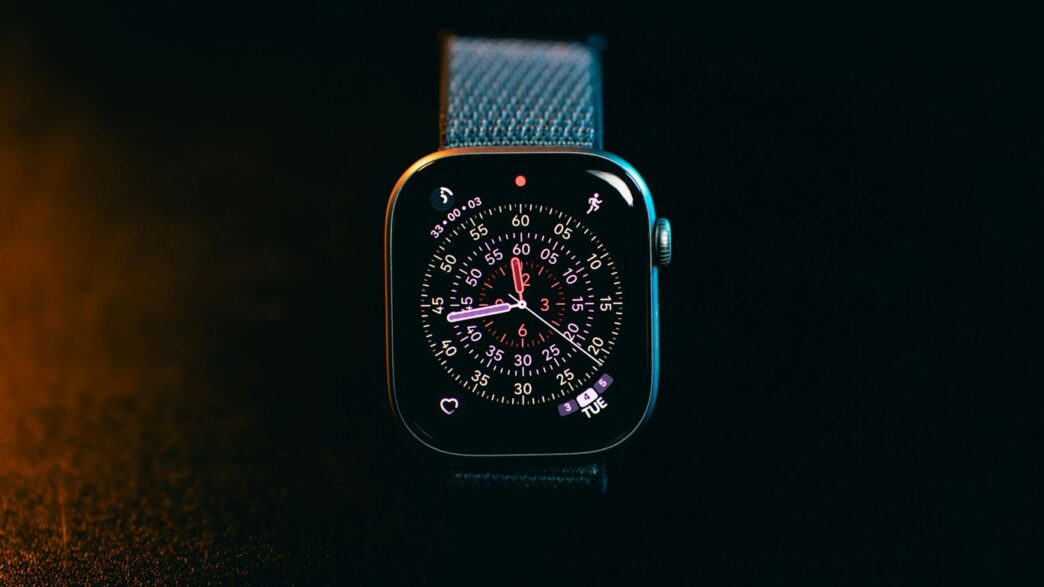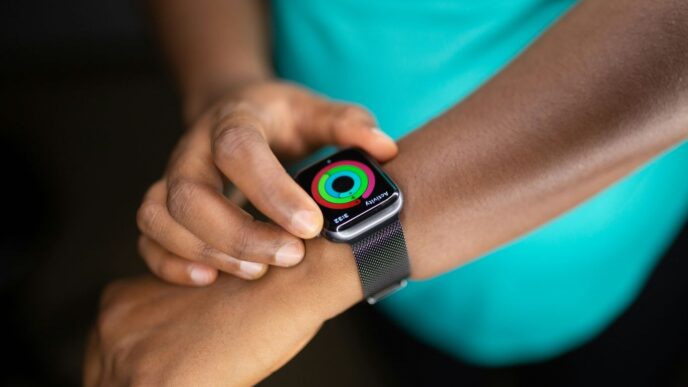So, you’re wondering about the Whoop 5.0 release date? It’s a big question for anyone keeping tabs on fitness trackers. Whoop has really made a name for itself, moving from something a bit different to a top player in the game. People are always curious about what’s next, especially with new hardware and software updates. Let’s break down what we know, or think we know, about the upcoming Whoop 5.0.
Key Takeaways
- The Whoop 5.0 is expected to be about 7% smaller than the previous model, making it more comfortable to wear. It’s also getting a significant boost in battery life, aiming for 14 days or more on a single charge.
- Inside, there’s a new processor that’s 60% faster, which should mean quicker syncing and a smoother app experience. The app itself is getting a makeover with a cleaner home screen and better activity auto-detection.
- For those into strength training, Whoop 5.0 will have more integrated metrics, making it easier to track your progress in that area. Plus, new features like Healthspan scoring and an advanced AI Coach are on the way.
- Heads up: If you have Whoop 4.0 bands, they won’t work with the new 5.0 or MG devices. However, your existing Whoop Body apparel should still be compatible.
- The membership model is sticking around, and there will be different tiers, including a premium ‘MG’ version with added features like ECG capabilities and heart rhythm notifications.
Anticipated Whoop 5.0 Release Date and Timeline
Evolution of Whoop: From Concept to Market Leader
Whoop has come a long way since it first hit the scene. Back in 2012, when Will Ahmed founded the company, the idea of a continuous wearable tracker wasn’t quite mainstream. It was a bit of a niche concept, really. Fast forward to today, and Whoop has gone from that somewhat unusual wrist gadget to a leader in the fitness tracker market. It’s been a steady climb, with each version building on the last.
Key Milestones in Whoop’s Product History
Looking back, Whoop’s journey is marked by some pretty significant steps:
- WHOOP 1.0 (2014): This was the first real multi-day wearable that could track your heart rate continuously. Pretty groundbreaking at the time.
- WHOOP 2.0 (2016): They added more health tracking features, making it more than just a fitness device.
- WHOOP 3.0 (2019): This version brought us WHOOP Live and a noticeable bump in battery life, which is always a big deal for wearables.
- WHOOP 4.0 (2021): A big design change here – it got smaller, and they packed in new sensors like SpO2 and skin temperature. Plus, they introduced WHOOP Body apparel.
Projected Release Window for Whoop 5.0
So, when can you actually get your hands on the Whoop 5.0? While the company is usually pretty tight-lipped about exact dates, based on their past release cycles and industry chatter, we’re looking at a likely launch sometime in mid-to-late 2025. They’ve been refining the tech, and the 4.0 came out in 2021, so a four-year gap isn’t out of the question. Keep an eye out, as announcements usually ramp up a few months before the actual release.
Hardware Innovations in Whoop 5.0
Alright, let’s talk about what’s new on the physical side of the Whoop 5.0. They’ve definitely been busy in the lab, making some noticeable tweaks that should make a difference in your day-to-day wear.
Reduced Device Size and Enhanced Comfort
First off, the Whoop 5.0 is actually smaller. We’re talking about a 7% reduction in size compared to the 4.0. This might not sound like a huge deal, but when you’re wearing something 24/7, even small changes can add up to more comfort. It’s a bit lighter too, which is always a plus. They’ve also managed to pack in a processor that’s 60% faster. What does that mean for you? Well, syncing your data should be quicker, and you might notice fewer little delays when you’re interacting with the device or the app. It’s these kinds of behind-the-scenes upgrades that make the whole experience feel smoother.
Extended Battery Life and Charging Options
This is a big one for a lot of people. Whoop is claiming a battery life of 14 days or more for the 5.0. That’s a solid jump from previous versions. Plus, they’ve introduced a new wireless Power Pack that can hold a charge for up to 30 days. So, if you’re someone who travels a lot or just hates having to charge things constantly, this is definitely good news. You’ll still have the option for wired charging too, with different types of chargers available.
Internal Component Upgrades and Sensor Architecture
While it might look similar on the outside, there have been some internal changes. You might hear some chatter that the sensors are the same, but digging a bit deeper, it seems like the internal components and sensor architecture have indeed been updated. These aren’t just minor tweaks; they’re designed to improve how the device collects and processes your physiological data. The faster processor we mentioned earlier is part of this, helping to handle the data more efficiently. It’s all about getting more accurate readings and a better overall picture of your body’s performance and recovery.
Software and App Enhancements for Whoop 5.0
Alright, so Whoop isn’t just about slapping a new sensor on your wrist and calling it a day. They’ve actually put some thought into making the app experience better with Whoop 5.0. It feels like they’re trying to make things a bit more straightforward, which is good because sometimes all those numbers can be a lot.
Streamlined App Interface and Home Screen Features
Remember how the Whoop app used to be a bit of a maze? Well, they’re cleaning that up. A lot of the personalized plans and daily tips that used to be buried a few taps away are now front and center on the home screen. This means you can get a quick look at what Whoop thinks you should focus on for the day without digging around. It’s like your daily briefing, right there when you open the app. They’ve also made some general tweaks to how things look, aiming for a cleaner feel overall. This makes it easier to see your key stats at a glance.
Improved Activity Auto-Detection Capabilities
This is one of those things that sounds small but makes a big difference. Whoop is getting smarter about figuring out when you actually start and stop working out. No more forgetting to hit the start button on your run or having the app think you’re still exercising when you’re just walking to get coffee. The goal here is more accurate tracking without you having to constantly babysit the app. It should pick up on activities like walking, running, and cycling more reliably, and hopefully, it’ll get better at recognizing a wider range of movements too.
Deeper Integration of Strength Training Metrics
For a while now, people have been asking for Whoop to get more serious about strength training. While it’s never been its primary focus, Whoop 5.0 is making strides. You’ll see strength training metrics showing up more clearly in your daily Strain breakdown. They’re also building on their acquisition of PUSH, which was all about velocity-based training (VBT). This means Whoop is trying to give you a better picture of the actual effort you’re putting into lifting weights, not just how high your heart rate gets. It’s not going to replace a dedicated strength training app overnight, but it’s a step in the right direction for folks who lift weights regularly.
Understanding Strain and Recovery Metrics
Alright, let’s talk about the core of what Whoop does: Strain and Recovery. These two metrics are pretty much the engine that drives the whole system, telling you how hard you pushed and how ready your body is to do it all again. It’s not just about hitting a number; it’s about understanding what those numbers actually mean for you.
Personalized Heart Rate Zones for Endurance Strain
When you’re out for a run, a bike ride, or any kind of cardio, Whoop looks at your heart rate and how long you keep it elevated. The longer you stay in higher heart rate zones, the more strain you accumulate. But here’s the neat part: Whoop doesn’t use generic zones. It figures out your personal heart rate zones based on your physiology. This means the strain you see is tailored to your body, not some average person’s. This personalized approach is key to getting actionable insights from your workouts. It helps you push hard enough to get a good training effect without going so far that you wreck your recovery.
The Role of Heart Rate Variability in Recovery
Recovery is where things get really interesting, and Heart Rate Variability (HRV) is a big player here. Think of HRV as a window into your nervous system’s balance. When you’re well-rested and your body is handling stress well, your HRV tends to be higher and more stable. When you’re run down, sick, or just overly fatigued, your HRV usually dips. Whoop measures your HRV overnight, when your body is in a resting state, to get a baseline. This nightly reading is a major component of your overall recovery score, giving you a daily snapshot of how prepared your body is to handle more Strain.
How Whoop 5.0 Quantifies Physiological Effort
So, how does Whoop 5.0 put all this together? For endurance activities, it’s primarily heart rate over time. The harder and longer you go, the higher the strain. But for strength training, it’s a bit more complex. Since just looking at heart rate during lifting doesn’t tell the whole story about muscle fatigue, Whoop has developed algorithms that try to model the muscular strain more directly. It considers reps, weight, and velocity (if you’re tracking it) to give you a more accurate picture of the effort your muscles put in. This combined approach, looking at both cardiovascular and muscular load, then feeds into your recovery score, helping you understand the total physiological demand placed on your body.
New Insights and Coaching Features
WHOOP 5.0 is really stepping up its game when it comes to giving you more than just raw data. It’s like having a personal coach who actually understands what your body is telling you.
Exploring Healthspan and Biological Age Scoring
This is pretty neat. Instead of just looking at how you’re doing today, WHOOP 5.0 is starting to look at the bigger picture – your long-term health. It uses a bunch of different things, like your VO2 max, how much time you spend in different heart rate zones, and other markers, to give you an idea of your "pace of aging." It’s not just about how old you are on paper, but how your body is functioning. The system then points out the lifestyle choices that seem to be affecting this score, which is super helpful for making changes that matter down the road. Think of it as a way to see if your habits are helping you live healthier for longer.
The Advanced AI Coach for Personalized Guidance
The WHOOP Coach is getting a serious upgrade. It’s not just spitting out generic advice anymore. This AI is built to have actual conversations with you, using your own biometric data and a big database of sports science. It remembers what you’ve talked about before, so it can give you advice that’s more tailored to you and your history. You can ask it questions about your recovery, your sleep, or why you felt sluggish on a certain day, and it’ll break it down for you. It’s designed to save you time trying to figure things out yourself or looking up complex health topics. It’s integrated throughout the app, popping up with insights when you need them, or you can chat with it directly.
Understanding Velocity-Based Training Integration
For those who are serious about strength training, WHOOP 5.0 is bringing in Velocity-Based Training (VBT) insights. This means it’s looking at how fast you’re moving the weight during your lifts. Why does that matter? Well, the speed of your movement can tell you a lot about how fatigued you are and what kind of training stimulus you’re getting. WHOOP 5.0 aims to use this data, along with your other metrics, to give you a clearer picture of your strength training performance and help you adjust your workouts accordingly. It’s about making sure you’re not just lifting heavy, but lifting effectively for your goals.
Whoop 5.0 Accessories and Compatibility
So, you’re thinking about upgrading to the Whoop 5.0, or maybe you’re just curious about what comes with it and what you can use from your old gear. Let’s break down the accessories and compatibility situation.
New Strap Mechanism and Band Incompatibility
First things first, if you have a collection of Whoop 4.0 bands, you’re going to need to get new ones for the 5.0. The new strap mechanism on the Whoop 5.0 means that older bands simply won’t fit. It’s a bummer, I know. They’ve changed the way the clasp and slider work, so those old favorites are now just… old.
WHOOP Body Apparel and Optimal Sensor Placement
Now, for the good news: your Whoop Body apparel is still compatible. This includes things like the compression shirts, shorts, and joggers. These are designed to hold the Whoop sensor in specific places for accurate readings, especially during workouts. While you can wear the sensor on your wrist most of the time, for exercise, especially things like team sports or strength training, placing it on the bicep is often recommended for the best heart rate data. The Whoop Body gear makes this super easy.
Here’s a quick rundown of where to place the sensor for different activities:
- Wrist: Standard placement for daily wear and sleep tracking.
- Bicep: Ideal for most sports and strength training, offering high accuracy.
- Calf/Glute (via apparel): Can work for some activities, but generally less accurate for heart rate than the wrist or bicep.
Customization Options for Bands and Devices
While you have to buy new bands, Whoop is offering more ways to personalize your look with the 5.0. You can expect a wider range of colors and materials for the bands themselves. Plus, they’re hinting at more customization options for the device’s metal casing, so you can really make your Whoop 5.0 stand out from the crowd. It’s a nice touch if you like your tech to match your style.
Membership Model and Premium Tiers
Unlike a lot of fitness trackers you buy once and then you’re done, WHOOP operates on a membership model. It’s a subscription thing, and they’ve tweaked it over the years, but now they’ve got these different tiers. It means you’re not just paying for the hardware; you’re paying for the ongoing insights and the app experience, which is where they really put their focus. They even throw in free upgrades to new hardware when they come out, which is pretty neat.
Understanding the Subscription-Based Approach
So, the deal with WHOOP is that you’re essentially subscribing to their service, not just buying a gadget. This subscription covers access to the app, all the data analysis, personalized coaching, and even hardware upgrades. It’s a bit different from, say, buying a smartwatch where you pay upfront and then maybe pay for some premium app features later. With WHOOP, the membership is the whole package. They’ve structured it so that the ongoing cost gives you access to continuous improvements and new features as they roll them out. It’s a commitment, sure, but they argue it’s worth it for the constant stream of data and guidance.
Features of the WHOOP 5.0 vs. WHOOP MG
When you’re looking at the different membership options, you’ll notice there are distinctions, especially between the standard WHOOP 5.0 plans and the more advanced ‘MG’ (which stands for ‘Medical Grade’ or similar, though they don’t always spell it out) tiers. The standard WHOOP 5.0 plans give you the core sleep, strain, and recovery insights, plus coaching and basic health metrics like VO2 Max and heart rate zones. The MG tiers, however, unlock more specialized features. For example, the ‘Life’ tier includes things like an ECG heart screener to check for AFib and, in beta, daily blood pressure estimations. These advanced features are medically focused and come with more restrictions and require specific hardware, sometimes even a different band than the standard WHOOP 5.0.
Exploring Subscription Tiers and Their Benefits
WHOOP offers a few different subscription levels, each with its own set of perks and price points. It’s not just one-size-fits-all.
- WHOOP 5.0 One: This is your entry-level plan. It covers the essentials: sleep tracking, strain monitoring, recovery scores, personalized coaching, and basic health metrics. It’s a solid choice if you’re looking to get a good handle on your daily readiness and training.
- WHOOP 5.0 Peak: Stepping up to the Peak tier gets you everything in the One plan, plus some extra features. You’ll gain access to healthspan and pace of aging scores, a health monitor with alerts, and a daily stress monitor. This is for folks who want a more in-depth look at their long-term health and real-time stress.
- WHOOP MG Life: This is the top-tier plan. It includes all the Peak features and adds advanced medical-grade capabilities. This tier is where you’ll find the ECG heart screener for AFib detection and the beta blood pressure monitoring. It also comes with its own specialized band. This is for the serious biohacker or someone who wants the most cutting-edge health monitoring available through WHOOP.
Here’s a quick look at how the pricing might shake out (note that these are approximate and can vary by region and promotions):
| Tier | Plan Type | Approx. Monthly (USD) | Approx. Annual (USD) |
|---|---|---|---|
| WHOOP 5.0 One | Monthly | $25 | $149 |
| WHOOP 5.0 Peak | Monthly | $30 | $220 |
| WHOOP MG Life | Monthly | $40 | $330 |
Choosing the right tier really depends on what you want to get out of your WHOOP. If you’re just starting and want to understand your recovery and strain, the One plan is probably fine. But if you’re interested in deeper health insights or advanced monitoring, you’ll want to look at the Peak or Life plans.
So, What’s the Verdict on WHOOP 5.0?
Alright, so we’ve gone over all the new bells and whistles for the WHOOP 5.0. It looks like they’ve really listened to users, making it smaller, giving it a much better battery life, and tweaking the app to make things easier to find. The new AI Coach and insights like Healthspan sound pretty interesting too, especially if you’re really trying to dial in your training and overall wellness. It’s definitely a step up from the 4.0, and if you’re already a WHOOP fan or looking for a serious fitness tracker, this seems like a solid upgrade. Just remember, the older bands won’t work, so you’ll need new accessories if you jump on board. Overall, WHOOP 5.0 is shaping up to be a pretty impressive piece of tech for anyone serious about understanding their body.
Frequently Asked Questions
When is Whoop 5.0 coming out?
While there’s no official date yet, Whoop 5.0 is expected to be released sometime in 2025. Keep an eye out for announcements from Whoop!
What’s new with the Whoop 5.0 hardware?
The new Whoop 5.0 will be about 7% smaller and lighter than the previous version, making it even more comfortable to wear. It also boasts a much faster processor and a battery that lasts over 14 days on a single charge.
Will my old Whoop bands work with the 5.0?
Unfortunately, no. The new strap design on the Whoop 5.0 means that bands made for the Whoop 4.0 won’t fit. However, Whoop’s special apparel, like their shirts and shorts with built-in sensor pockets, will still work.
What kind of new insights can I get with Whoop 5.0?
Whoop 5.0 is bringing some exciting new features. You’ll be able to explore things like your ‘healthspan’ (how long you might live in good health) and get even more personalized advice from an advanced AI Coach. It also has better tools for tracking strength training.
How does Whoop 5.0 measure my effort during workouts?
Whoop 5.0 calculates your ‘strain’ by looking at your heart rate during exercise. It figures out how hard you’re working by comparing your heart rate to your personal best zones and how long you stay in those zones. It also uses how well you recover overnight to give you a complete picture.
Is Whoop 5.0 worth upgrading to?
If you’re looking for a more comfortable device with a longer battery life and advanced new features for tracking your health and fitness, then yes, upgrading to Whoop 5.0 could be a great choice. The improvements in the app and the new insights offer a lot more value.














